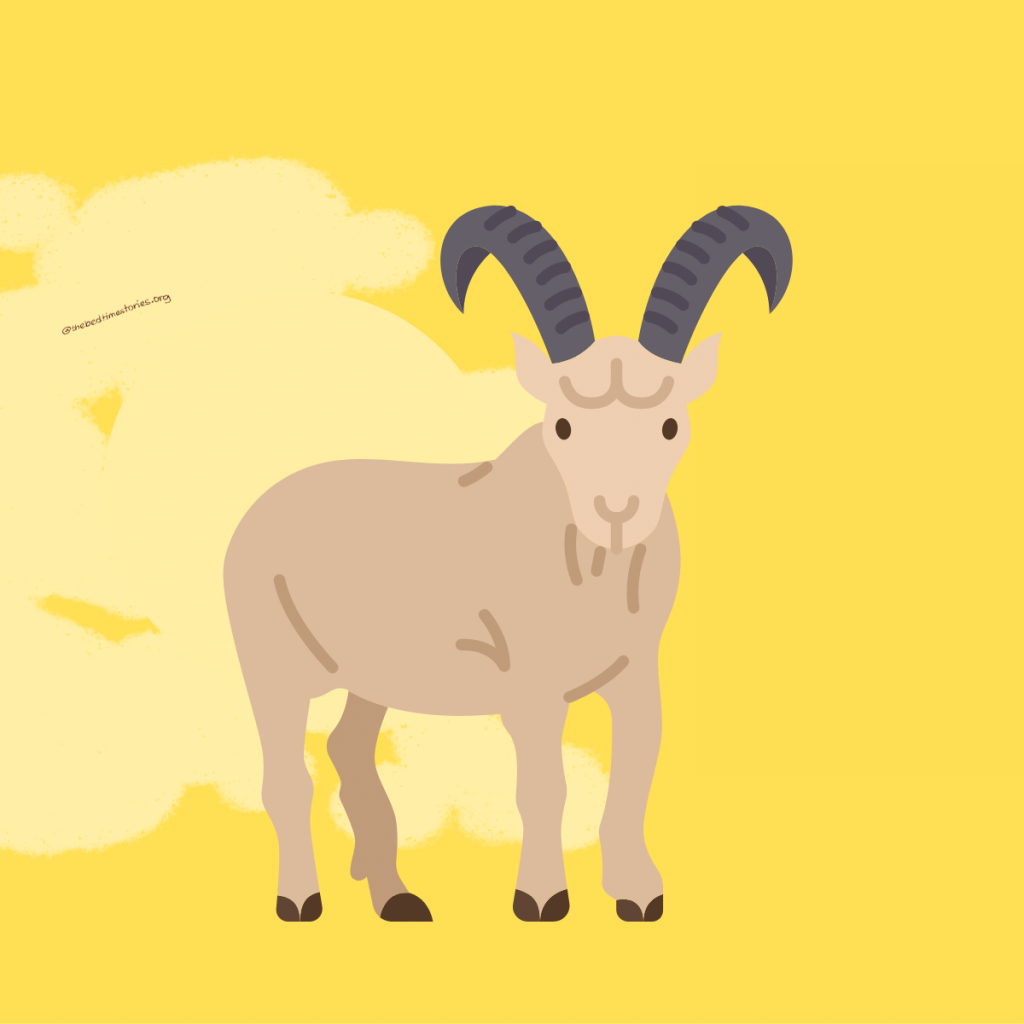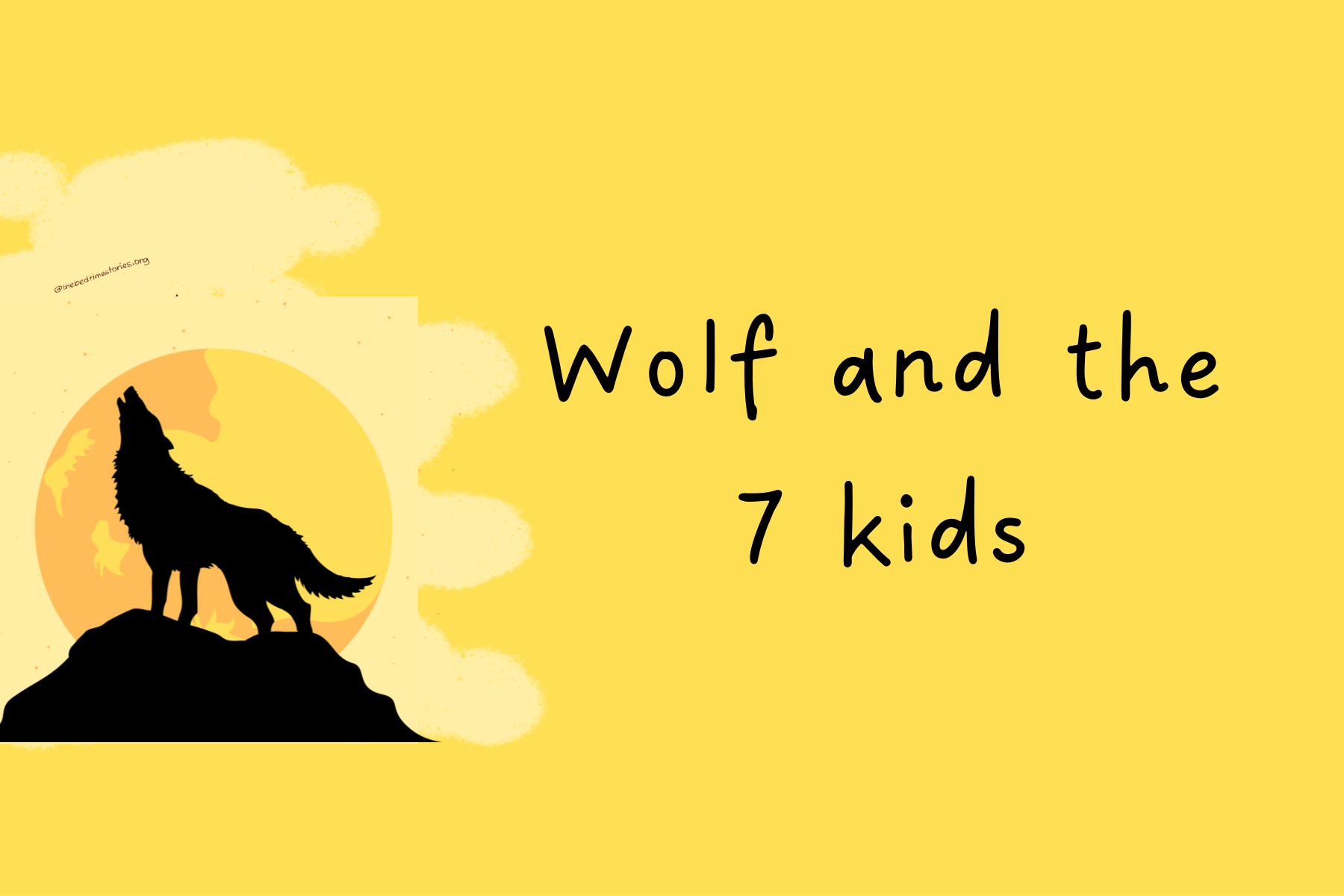The Wolf And 7 Kids: by Grimm Brothers
There was once upon a time an old goat who had seven little kids, and
loved them with all the love of a mother for her children. One day
she wanted to go into the forest and fetch some food.

So she called all seven to her and said, dear children, I have to go into the
forest, be on your guard against the wolf, if he comes in, he will
devour you all – skin, hair, and everything. The wretch often
disguises himself, but you will know him at once by his rough voice
and his black feet.
The kids said, dear mother, we will take good
care of ourselves, you may go away without any anxiety. Then the old
one bleated, and went on her way with an easy mind.
It was not long before some one knocked at the house-door and called,
open the door, dear children, your mother is here, and has brought
something back with her for each of you. But the little kids knew
that it was the wolf, by the rough voice. We will not open the door,
cried they, you are not our mother.
She has a soft, pleasant voice, but your voice is rough, you are the wolf. Then the wolf went away to a shopkeeper and bought himself a great lump of chalk, ate this and made his voice soft with it.
Then he came back, knocked at the door of the house, and called, open the door, dear children, your mother is here and has brought something back with her for each of you.

But the wolf had laid his black paws against the window, and
the children saw them and cried, we will not open the door, our
mother has not black feet like you, you are the wolf. Then the wolf
ran to a baker and said, I have hurt my feet, rub some dough over
them for me. And when the baker had rubbed his feet over, he ran to
the miller and said, strew some white meal over my feet for me. The
miller thought to himself, the wolf wants to deceive someone, and
refused, but the wolf said, if you will not do it, I will devour you.
Then the miller was afraid, and made his paws white for him. Truly,
this the way of mankind.

So now the wretch went for the third time to the house-door, knocked
at it and said, open the door for me, children, your dear little
mother has come home, and has brought every one of you something back
from the forest with her.
The little kids cried, first show us your paws that we may know if you are our dear little mother. Then he put his paws in through the window, and when the kids saw that they were white, they believed that all he said was true, and opened the door.
But who should come in but the wolf they were terrified and wanted to
hide themselves. One sprang under the table, the second into the
bed, the third into the stove, the fourth into the kitchen, the fifth
into the cupboard, the sixth under the washing-bowl, and the seventh
into the clock-case.
But the wolf found them all, and used no great
ceremony, one after the other he swallowed them down his throat. The
youngest, who was in the clock-case, was the only one he did not
find. When the wolf had satisfied his appetite he took himself off,
laid himself down under a tree in the green meadow outside, and began
to sleep. Soon afterwards the old goat came home again from the
forest. Ah. What a sight she saw there. The house-door stood wide
open. The table, chairs, and benches were thrown down, the
washing-bowl lay broken to pieces, and the quilts and pillows were
pulled off the bed. She sought her children, but they were nowhere
to be found. She called them one after another by name, but no one
answered. At last, when she caame to the youngest, a soft voice
cried, dear mother, I am in the clock-case.
She took the kid out, and it told her that the wolf had come and had eaten all the others. Then you may imagine how she wept over her poor children.
At length in her grief she went out, and the youngest kid ran with
her. When they came to the meadow, there lay the wolf by the tree
and snored so loud that the branches shook. She looked at him on
every side and saw that something was moving and struggling in his
gorged belly. Ah, heavens, she said, is it possible that my poor
children whom he has swallowed down for his supper, can be still
alive.
Then the kid had to run home and fetch scissors, and a needle
and thread and the goat cut open the monster’s stomach, and hardly
had she make one cut, than one little kid thrust its head out, and
when she cut farther, all six sprang out one after another, and were
all still alive, and had suffered no injury whatever, for in his
greediness the monster had swallowed them down whole.
What rejoice there was. They embraced their dear mother, and jumped like a sailor
at his wedding. The mother, however, said, now go and look for some
big stones, and we will fill the wicked beast’s stomach with them
while he is still asleep. Then the seven kids dragged the stones
thither with all speed, and put as many of them into his stomach as
they could get in, and the mother sewed him up again in the greatest
haste, so that he was not aware of anything and never once stirred.
When the wolf at length had had his fill of sleep, he got on his
legs, and as the stones in his stomach made him very thirsty, he
wanted to go to a well to drink. But when he began to walk and move
about, the stones in his stomach knocked against each other and
rattled. Then cried he, what rumbles and tumbles against my poor
bones. I thought ’twas six kids, but it feels like big stones. And
when he got to the well and stooped over the water to drink, the
heavy stones made him fall in, and he had to drown miserably. When
the seven kids saw that, they came running to the spot and cried
aloud, the wolf is dead. The wolf is dead, and danced for joy round
about the well with their mother.
The Wolf And 7 Kids by Grimm Brothers
The Wolf And 7 Kids in Children’s Fairy Tales is familiar. It’s one of the quintessential short stories in every children’s book. Written by the Grimm brothers, it is a monumental piece of children’s literature.
Edit Your Photos Like Storybook Cartoons: Click Here
Read more short stories like ‘The Wolf And 7 Kids’
About Grimm Brothers:
(via Wikipedia)
The Brothers Grimm (die Brüder Grimm or die Gebrüder Grimm), Jacob (1785–1863) and Wilhelm (1786–1859), were German academics, philologists, cultural researchers, lexicographers, and authors who together collected and published folklore.
They are among the best-known storytellers of folk tales, popularizing stories such as “Cinderella” (“Aschenputtel”), “The Frog Prince” (“Der Froschkönig”), “Hansel and Gretel” (“Hänsel und Gretel”), “Little Red Riding Hood” (“Rotkäppchen”), “Rapunzel”, “Rumpelstiltskin” (“Rumpelstilzchen”), “Sleeping Beauty” (“Dornröschen”), and “Snow White” (“Schneewittchen”). Their first collection of folk tales, Children’s and Household Tales (Kinder- und Hausmärchen), began publication in 1812.
Read more like ‘The Wolf And 7 Kids’: More Stories
The brothers spent their formative years in the town of Hanau in the Landgraviate of Hesse-Kassel. Their father’s death in 1796 (when Jacob was eleven and Wilhelm was ten) caused great poverty for the family and affected the brothers many years after.
Read more like ‘The Wolf And 7 Kids’: Adventure Stories
Both brothers attended the University of Marburg, where they became curious about German folklore, which grew into a lifelong dedication to collecting German folk tales.
Read more like ‘The Wolf And 7 Kids’: Kid’s Stories
The rise of romanticism in the 19th century revived interest in traditional folk stories, which to the brothers represented a pure form of national literature and culture. Intending to research a scholarly treatise on folk tales, they established a methodology for collecting and recording folk stories that became the basis for folklore studies.
Read more like ‘The Wolf And 7 Kids’: Fairy Tales
Between 1812 and 1857 their first collection was revised and republished many times, growing from 86 stories to more than 200. In addition to writing and modifying folk tales, the brothers wrote collections of well-respected German and Scandinavian mythologies.
Read more like ‘The Wolf And 7 Kids’: Moral Stories
In 1838 they began writing a definitive German dictionary (Deutsches Wörterbuch) which they could not finish during their lifetimes.
Read more like ‘The Wolf And 7 Kids’: Kid’s Stories
The popularity of the Grimms’ collected folk tales has endured well. The tales are available in more than 100 translations and have been adapted by filmmakers (including Lotte Reiniger and Walt Disney), in films such as Snow White and the Seven Dwarfs.
Read more like ‘The Wolf And 7 Kids’: Fables
In the mid-20th century, the tales were used as propaganda by Nazi Germany; later in the 20th century, psychologists such as Bruno Bettelheim reaffirmed the value of the work despite the cruelty and violence in original versions of some of the tales, which the Grimms eventually sanitized.
